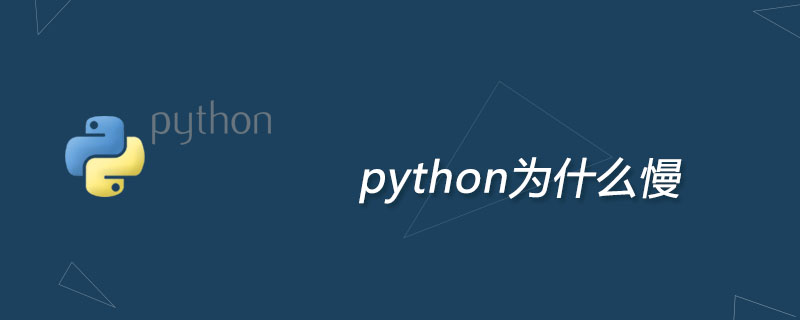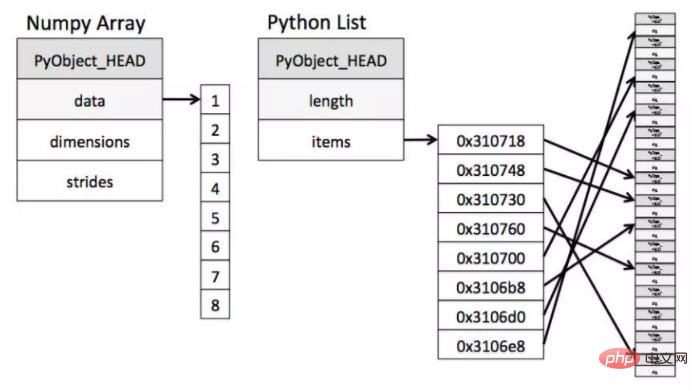Why is python slow?
Python is a dynamically typed, interpreted language. For many developers, it is well known that Python runs slowly. Its characteristic that everything is an object is one of the reasons for its slow running. The following article explains Let me introduce to you some reasons why python is slow. I hope it will be helpful to you.

Python is a dynamic language, not a static language
This means that when the python program is executed, it is compiled The compiler does not know the type of the variable. In C, the compiler knows the type of a variable when it is defined, but in python it only knows that it is an object when executed.
So if you write the following in C:
/ * C代码* / int a = 1 ; int b = 2 ; int c = a + b ;
The C compiler knows from the start that a and b are integers: they simply cannot be anything else! With this knowledge, it can call a routine that adds two integers, returning another integer that is just a simple value in memory.
The process executed in C is roughly as follows:
1. Assign
2. Assign
3. Call binary addition binary_add(a, b)
4. Assign the structure to a c variable
python medium The effective code is as follows:
# python code a = 1 b = 2 c = a + b
Here the interpreter only knows that 1 and 2 are objects, but does not know what type of objects they are. So the interpreter must check each variable's PyObject_HEAD to find the type information, and then call the appropriate summation routine for both types. Finally, it must create and initialize a new Python object to hold the return value.
The execution process is roughly as follows:
1. Assign 1 to a
(1) Set a->PyObject_HEAD->typecode to an integer
(2) Set Seta->val = 1
2, assign 2 to b
(1) Set b->PyObject_HEAD->typecode to an integer
(2) Set b->val = 2
3. Call binary addition binary_add(a, b)
(1) Find the type code a->PyObject_HEAD
(2) a is an integer, the value is a->val
(3) Find the type code b->PyObject_HEAD
(4) b is an integer, the value is b ->val
(5) Call binary addition binary_add(a->val, b->val)
(6) The result is result, which is an integer.
4. Create a new object c
(1) Set c->PyObject_HEAD->typecode to an integer
(2) Assign c->val Giving the result
dynamic typing means any operation requires more steps. This is the main reason why Python is slower than C when it comes to numerical data operations.
Python is an interpreted language rather than a compiled language
The differences between interpreted languages and compiled languages will also cause differences in the speed of program execution. . An intelligent compiler can predict and optimize for repetitive and unnecessary operations. This will also increase the speed of program execution.
Python’s object model will bring inefficient memory access
In the above example, compared to the C language, operating on integers in Python will cause An additional layer of type information. When there are a lot of integers and you want to perform some kind of batch operation, a list is often used in python, and a buffer-based array is used in C. In its simplest form, a Numpy array is a Python object built around an array in C. That is to say, Numpy has a pointer pointing to the value of the continuous cache area data, while in python, the python list has a pointer that only wants to cache the area. Each pointer points to a python cache object, and each object is bound to a data (an integer in this case).
Schematic diagrams of these two situations:

It can be clearly seen from the above figure that when operating on data (such as sorting, calculation , search, etc.), Numpy is more efficient than python in terms of survival cost and access cost.
The above is the detailed content of Why is python slow?. For more information, please follow other related articles on the PHP Chinese website!

Hot AI Tools

Undresser.AI Undress
AI-powered app for creating realistic nude photos

AI Clothes Remover
Online AI tool for removing clothes from photos.

Undress AI Tool
Undress images for free

Clothoff.io
AI clothes remover

AI Hentai Generator
Generate AI Hentai for free.

Hot Article

Hot Tools

Notepad++7.3.1
Easy-to-use and free code editor

SublimeText3 Chinese version
Chinese version, very easy to use

Zend Studio 13.0.1
Powerful PHP integrated development environment

Dreamweaver CS6
Visual web development tools

SublimeText3 Mac version
God-level code editing software (SublimeText3)

Hot Topics
 1384
1384
 52
52
 PHP and Python: Code Examples and Comparison
Apr 15, 2025 am 12:07 AM
PHP and Python: Code Examples and Comparison
Apr 15, 2025 am 12:07 AM
PHP and Python have their own advantages and disadvantages, and the choice depends on project needs and personal preferences. 1.PHP is suitable for rapid development and maintenance of large-scale web applications. 2. Python dominates the field of data science and machine learning.
 Python vs. JavaScript: Community, Libraries, and Resources
Apr 15, 2025 am 12:16 AM
Python vs. JavaScript: Community, Libraries, and Resources
Apr 15, 2025 am 12:16 AM
Python and JavaScript have their own advantages and disadvantages in terms of community, libraries and resources. 1) The Python community is friendly and suitable for beginners, but the front-end development resources are not as rich as JavaScript. 2) Python is powerful in data science and machine learning libraries, while JavaScript is better in front-end development libraries and frameworks. 3) Both have rich learning resources, but Python is suitable for starting with official documents, while JavaScript is better with MDNWebDocs. The choice should be based on project needs and personal interests.
 How is the GPU support for PyTorch on CentOS
Apr 14, 2025 pm 06:48 PM
How is the GPU support for PyTorch on CentOS
Apr 14, 2025 pm 06:48 PM
Enable PyTorch GPU acceleration on CentOS system requires the installation of CUDA, cuDNN and GPU versions of PyTorch. The following steps will guide you through the process: CUDA and cuDNN installation determine CUDA version compatibility: Use the nvidia-smi command to view the CUDA version supported by your NVIDIA graphics card. For example, your MX450 graphics card may support CUDA11.1 or higher. Download and install CUDAToolkit: Visit the official website of NVIDIACUDAToolkit and download and install the corresponding version according to the highest CUDA version supported by your graphics card. Install cuDNN library:
 Detailed explanation of docker principle
Apr 14, 2025 pm 11:57 PM
Detailed explanation of docker principle
Apr 14, 2025 pm 11:57 PM
Docker uses Linux kernel features to provide an efficient and isolated application running environment. Its working principle is as follows: 1. The mirror is used as a read-only template, which contains everything you need to run the application; 2. The Union File System (UnionFS) stacks multiple file systems, only storing the differences, saving space and speeding up; 3. The daemon manages the mirrors and containers, and the client uses them for interaction; 4. Namespaces and cgroups implement container isolation and resource limitations; 5. Multiple network modes support container interconnection. Only by understanding these core concepts can you better utilize Docker.
 MiniOpen Centos compatibility
Apr 14, 2025 pm 05:45 PM
MiniOpen Centos compatibility
Apr 14, 2025 pm 05:45 PM
MinIO Object Storage: High-performance deployment under CentOS system MinIO is a high-performance, distributed object storage system developed based on the Go language, compatible with AmazonS3. It supports a variety of client languages, including Java, Python, JavaScript, and Go. This article will briefly introduce the installation and compatibility of MinIO on CentOS systems. CentOS version compatibility MinIO has been verified on multiple CentOS versions, including but not limited to: CentOS7.9: Provides a complete installation guide covering cluster configuration, environment preparation, configuration file settings, disk partitioning, and MinI
 How to operate distributed training of PyTorch on CentOS
Apr 14, 2025 pm 06:36 PM
How to operate distributed training of PyTorch on CentOS
Apr 14, 2025 pm 06:36 PM
PyTorch distributed training on CentOS system requires the following steps: PyTorch installation: The premise is that Python and pip are installed in CentOS system. Depending on your CUDA version, get the appropriate installation command from the PyTorch official website. For CPU-only training, you can use the following command: pipinstalltorchtorchvisiontorchaudio If you need GPU support, make sure that the corresponding version of CUDA and cuDNN are installed and use the corresponding PyTorch version for installation. Distributed environment configuration: Distributed training usually requires multiple machines or single-machine multiple GPUs. Place
 How to choose the PyTorch version on CentOS
Apr 14, 2025 pm 06:51 PM
How to choose the PyTorch version on CentOS
Apr 14, 2025 pm 06:51 PM
When installing PyTorch on CentOS system, you need to carefully select the appropriate version and consider the following key factors: 1. System environment compatibility: Operating system: It is recommended to use CentOS7 or higher. CUDA and cuDNN:PyTorch version and CUDA version are closely related. For example, PyTorch1.9.0 requires CUDA11.1, while PyTorch2.0.1 requires CUDA11.3. The cuDNN version must also match the CUDA version. Before selecting the PyTorch version, be sure to confirm that compatible CUDA and cuDNN versions have been installed. Python version: PyTorch official branch
 How to update PyTorch to the latest version on CentOS
Apr 14, 2025 pm 06:15 PM
How to update PyTorch to the latest version on CentOS
Apr 14, 2025 pm 06:15 PM
Updating PyTorch to the latest version on CentOS can follow the following steps: Method 1: Updating pip with pip: First make sure your pip is the latest version, because older versions of pip may not be able to properly install the latest version of PyTorch. pipinstall--upgradepip uninstalls old version of PyTorch (if installed): pipuninstalltorchtorchvisiontorchaudio installation latest




